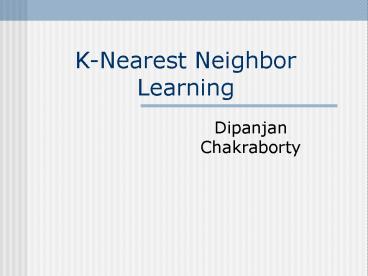K-Nearest Neighbor Learning - PowerPoint PPT Presentation
Title:
K-Nearest Neighbor Learning
Description:
K-Nearest Neighbor Learning Dipanjan Chakraborty Different Learning Methods Eager Learning Explicit description of target function on the whole training set Instance ... – PowerPoint PPT presentation
Number of Views:313
Avg rating:3.0/5.0
Title: K-Nearest Neighbor Learning
1
K-Nearest Neighbor Learning
- Dipanjan Chakraborty
2
Different Learning Methods
- Eager Learning
- Explicit description of target function on the
whole training set - Instance-based Learning
- Learningstoring all training instances
- Classificationassigning target function to a new
instance - Referred to as Lazy learning
3
Different Learning Methods
- Eager Learning
Any random movement gtIts a mouse
I saw a mouse!
4
Instance-based Learning
Its very similar to a Desktop!!
5
Instance-based Learning
- K-Nearest Neighbor Algorithm
- Weighted Regression
- Case-based reasoning
6
K-Nearest Neighbor
- Features
- All instances correspond to points in an
n-dimensional Euclidean space - Classification is delayed till a new instance
arrives - Classification done by comparing feature vectors
of the different points - Target function may be discrete or real-valued
7
1-Nearest Neighbor
8
3-Nearest Neighbor
9
K-Nearest Neighbor
- An arbitrary instance is represented by (a1(x),
a2(x), a3(x),.., an(x)) - ai(x) denotes features
- Euclidean distance between two instances
- d(xi, xj)sqrt (sum for r1 to n (ar(xi) -
ar(xj))2) - Continuous valued target function
- mean value of the k nearest training examples
10
Voronoi Diagram
- Decision surface formed by the training examples
11
Distance-Weighted Nearest Neighbor Algorithm
- Assign weights to the neighbors based on their
distance from the query point - Weight may be inverse square of the distances
- All training points may influence a particular
instance - Shepards method
12
Remarks
- Highly effective inductive inference method for
noisy training data and complex target functions - Target function for a whole space may be
described as a combination of less complex local
approximations - Learning is very simple
- - Classification is time consuming
13
Remarks
- - Curse of Dimensionality
14
Remarks
- - Curse of Dimensionality
15
Remarks
- - Curse of Dimensionality
16
Remarks
- Efficient memory indexing
- To retrieve the stored training examples (kd-tree)































